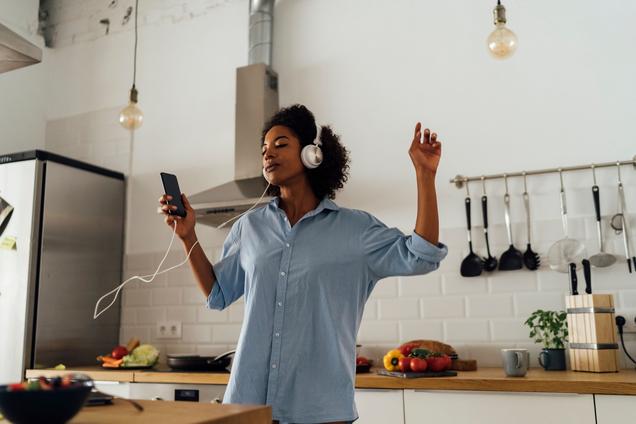7 Simple Ways To Move More When You're Not Leaving The House
For many of us, walking to the fridge or bathroom is the most movement we’re getting right now – and studies show we’re doing a lot less exercise, 40% less to be exact.
Our sloth-like habits aren’t going unnoticed – and our bodies are creaking and groaning because of it. “We’ve seen a significant rise in ‘lockdown’ injuries and pain, especially lower back pain and neck pain,” says Tim Allardyce, a physiotherapist and osteopath at Surrey Physio.
AdvertisementPatients “in increasing numbers” are struggling with neck ache from using laptops on kitchen tables, in bed, and increased phone use, and our bodies are becoming “de-conditioned”, says Allardyce.
The obvious solution to the problem is exercise, but for some people a full-blown run just isn’t possible right now – either because you’re self-isolating, don’t feel well, have zero motivation, or are worried about leaving the house.
AdvertisementSo what can you do?
Tom Jenkins, a physiotherapist at Physio Fitness Bournemouth, says the key is moving little and often. So, rather than sitting all day then doing one big load of exercise, it needs to be lots of little opportunities, he says.
AdvertisementIf you do sit all day, he recommends finding three working positions you can switch between: a standing area to work (this could be the kitchen counter or on top of your chest of drawers), a seated area with a well-supported chair, and sitting on a gym ball (if you have one, or find somewhere different to sit).
There are so many physical and mental benefits to adding movement into your daily routine – and the more you do it, the more it’ll become second nature.
Benefits include: preventing musculoskeletal aches and pains which can arise by relieving joint stiffness, reducing risk of RSI (repetitive strain injuries), improving circulation, improving alertness, and combatting tiredness, says Melanie Skeer, a chartered physiotherapist at Ascot Physio.
“From a physiotherapy aspect, ensuring you’re keeping all your muscles, tendons, ligaments, and joints moving through their respective movement cycles maintains strength and stability,” adds Jenkins. “Movement helps to regulate hormones and keep the body’s homeostasis, leading to a better mood, better sleep, lower blood pressure, and all-round better health.”
AdvertisementHere are some more ways you can add movement into your daily routine.
When you’re sat at your desk all day
Moving every hour can prevent those pesky aches and pains. So, set an alarm on your phone as a prompt to get up and move, suggests Skeer.
You might simply walk around your chair a few times. Or, you could do a few squats behind your chair, roll your shoulders around and swing the arms in circles. The arm-swinging has the added advantage of improving circulation down to the hands. “A lot of upper limb RSI are due to reduced circulation,” says Skeer, who adds that running on the spot would have the same circulatory effect on the lower limbs.

When you’re sat down, sideways neck stretches can relieve neck tension – tilt your right ear down towards your right shoulder, and then your left ear down towards your left shoulder.
Back side bends and arching backwards can help if you’ve been hunched over a computer all week. “About 10 repetitions, three times a day would be sufficient or you could do five every couple of hours throughout the working day,” Skeer suggests.
You might want to try rotating your upper torso when you’re sat down, too. “While sitting at your seat, gently twist as if you were to reach to touch the back of it,” says Allardyce. Repeat this 10 times on each side, to create a rotation or twist to your spine. “This is a great mobility exercise for your back to help improve range of movement in your spine,” he adds.
When you’re going to the kitchen for a snack
The snack cupboard is calling, but before you get there, do the door frame stretch. To do this, reach to the top of the door frame with your fingers, which will gently stretch through your shoulders. Hold the stretch for 10 seconds, and repeat five times. “This can help improve shoulder mobility and also can help if you are getting a bit round-shouldered,” says Allardyce.
When you’re on the phone
AdvertisementRemember that childhood game ‘the floor is lava’? Well, when you’re on the phone, any chair is lava. Don’t just sit there, get up and walk around. “If you are sitting for eight hours a day you have to combat that with movement elsewhere,” says Skeer. “Take telephone calls whilst walking around if possible.”
When you take a lunch break
Skeer is a big believer in using your lunch break to go for as long a walk as possible. “At least 20 minutes is preferable as this ensures full blood circulation is achieved,” she says.
If you can’t go out right now, for whatever reason, use your stairs to get your circulation flowing. Walk up and down them repeatedly to work on joint movement, leg strength and cardiovascular fitness, suggests Skeer.
“It’s ok to get a little out of breath doing this. If you get out of breath so you can’t speak then that is too much and ease back.”
When you’re homeschooling
Join in with the kids’ PE sessions, suggests Jenkins. Or, teach your kids to plank – Allardyce says he planks with his kids most days on the kitchen floor.
“Rest on your forearms and toes and hold your body in a straight position to form a plank,” he says. “Hold this position for as long as you feel comfortable and every few days try to increase the length of time you hold the plank for. If you find the exercise hard, rest on your knees instead of your toes. The plank can help build core and back strength.”
When your dinner is in the oven
You’ve got 35 minutes left until that delicious lasagne is ready, so what are you going to do in the meantime? No, not Netflix.
Advertisement“After work, try and be as active as possible,” suggests Skeer. You might want to try some online yoga or Pilates classes. If you’ve got an exercise bike, get on it, or try lifting some weights instead – bottles of mineral water, canned food or resistance bands can be used if you don’t have weights. HIIT workouts can also be done in the home with limited space.
You don’t have to do it for hours, just enough to get your heart pumping and circulation flowing. And if you truly can’t be bothered with finding an online class, turn on some music in the kitchen and dance around for 10 minutes.
Samantha Lisboa, a physiotherapist and Pilates instructor, says dance can change your mood, brighten up your environment, tone muscles, improve posture, increase self-confidence and relax the mind.
Alternatively if you’ve got a tonne of chores to do, household activities such as dusting, sweeping or mopping the floor are aerobic physical activities which stimulate the cardiorespiratory system.
When you’re getting up off the sofa
You’ve had your dinner and finished binge-watching Bridgerton – now it’s time for a toilet break. But before that, do a sofa squat (or two).
Sit on your sofa and use your legs to push up into a standing position. Now squat back down to the sofa, briefly touching your bum on the edge of the sofa, before standing back up again. Repeat this 10 times, suggests Allardyce, who says it’s a great strengthening exercise for your legs.
Suggest a correction More:HealthfitnessLifework from homeexerciseNatasha Hinde
Life reporter at HuffPost UK



